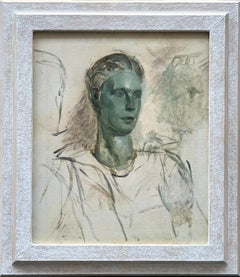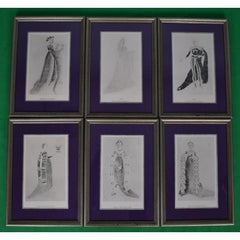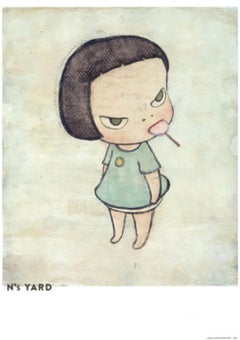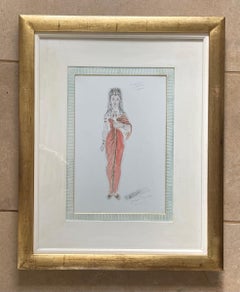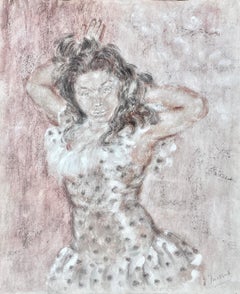Oliver Messel Art
British, 1904-1978
Born in London, his mother being the daughter of the Punch cartoonist Edward Linley Sambourne and his father a soldier and stockbroker. After Eton he studied art at the Slade under Henry Tonks; Rex Whistler was a fellow student. Although his studies concentrated on life drawings he also made papier mache and wax masks for student events and an exhibition of these masks at the Claridge Galleries in 1925 let to his first theatre design commission for the Diaghilev ballet production of Zeephyre et Flore. By the early 1930s had established himself as one of Britain’s principal designers for the stage. He went on to design for many theatrical, operatic, ballet and film productions becoming one of the most highly paid and sought after theatre designers in the world.
His books included Stage Designs and Costumes, 1933; Designs for A Midsummer Night’s Dream, 1957 and Delightful Food, 1958. He held one-man exhibitions at the Leicester Galleries and Redfern Gallery, designed interiors and gardens of the Dorchester Hotel, Flaxley Abbey, Gloucestershire and elsewhere as well as several houses and grounds in Barbados and Mustique. The Victoria & Albert Museum hold the majority of his design archives.to
1
1
Overall Width
to
Overall Height
to
2
1
1
2
2
1
1
1
1
1
1
1
1
1
1
1
2
10,138
2,779
1,375
1,367
2
1
1
Artist: Oliver Messel
Portrait of a Young Man Oil Painting Celebrated 20th Century Artist
By Oliver Messel
Located in London, GB
Oliver Messel
1904 - 1978
Portrait of a Young Man
Oil on canvas, signed and dated 'Oliver Messel 1930' (on the stretcher)
Image size: 30 x 25 inches (76.2 x 63.4 cm)
Original frame
Oliver Messel was born to Leonard and Maud Messel, née Sambourne, on the 13 January 1904 and was the youngest of three children. The family moved to Nymans, the Messel family home in Sussex, from nearby Balcombe in 1915. The house remained in the family until 1953 when it was bequeathed to the National Trust, following a fire in 1947 which destroyed a large portion of the house.
The Messels originated from a line of German Jewish bankers on Leonard’s side, however, both family lines boast a number of artistic influences, including Maud’s father. Maud was brought up at 18 Stafford Terrace, Kensington (now known as the Linley Sambourne House Museum), amongst collections of antique porcelain and eighteenth-century furniture, and with a host of artistic visitors such as Henry Irving and Oscar Wilde.
Oliver’s own upbringing appears to be influenced by his mother's, as the Messel family were also affiliated with artists and writers and were keen collectors of art, filling their home with textiles, paintings and collections of European and Asian fans from travels abroad. It was amongst such treasures that Oliver, Anne and Linley spent their childhood, in addition to the beauty of Nyman’s extensive gardens.
Oliver was schooled at Eton but rather than going up to university was encouraged by family friends, gallery owner Archie Propert and painter and sculptor Glyn Philpot, to attend art school. In 1922 he enrolled at the Slade School of Fine Art in London, where he studied under Henry Tonks. Here, he met the artist Rex Whistler with whom he remained firm friends until Whistler’s death in WW2.
Upon leaving the Slade in 1924 Oliver was apprenticed to the studio of portrait artist John Wells, where he learnt various Old Master painting techniques, and met artists such as Jacob Epstein, Augustus John and William Orpen.
Whilst at the Slade Oliver developed his interest in Papier Mâché masks, a pastime popular amongst many art students at the time. Whilst apprenticed to artist John Wells several of Oliver’s masks were exhibited at the Claridge Gallery, London, alongside pieces by Whistler and other young artists. These were seen by Serge Diaghilev, director of the Ballet Russes, and Charles B. Cochran, a theatrical producer, both of whom made Oliver offers of work.
His first job in the theatre was creating masks for the Ballets Russes’ Zéphyr et Flore, 1925, designed by the French artist Georges Braque, followed by numerous musical revues for Cochran, including Wake Up and Dream!, 1929, with music by Cole Porter. It was during these revues, working with Porter and Noel Coward, that Oliver also began to design headdresses and costumes. In 1932 he was rewarded with his first full commission to design both costume and sets for Helen!, directed by Max Reinhardt. The production design is still celebrated today for its innovative approach and ground-breaking ‘white on white’ aesthetic, which referenced ‘Greek temples, Rococo drapes, Baroque colonnades and Louis XIV carousels’.
The success of Helen! led to further offers within the theatre including Reinhardt’s version of A Midsummer Night’s Dream at the Old Vic in 1937, starring Vivien Leigh as Titania and Robert Helpmann as Oberon, the Jean Cocteau play The Infernal Machine in 1940, and Christopher Fry’s translation of Jean Anouilh’s Ring Round the Moon, 1950.
One of Oliver’s best-known productions during this period was the Russian ballet The Sleeping Beauty, performed by Sadler’s Wells Ballet in 1946 at the Royal Opera House, Covent Garden. Encompassing over 200 costumes and four set changes, Oliver’s romantic designs were celebrated for bringing colour back to post-war London, and variations on his designs are still used today. Additional designs for the ballet included Comus in 1940, for which he was released from war duties, and Homage to the Queen, choreographed by Frederick Ashton and performed in 1953 for the Queen’s coronation.
His first opera was in 1940 for Mozart’s Die Zauberflöte at the Royal Opera House, followed by a series of productions at the newly founded Glyndebourne Opera House in Sussex, for which Oliver also designed the proscenium arch. He triumphed in 1956 designing a season of four different productions for their Mozart bicentennial, also providing illustrations for the programme covers.
His popularity also spread beyond theatre to film, were he worked on over eight different feature films including Romeo and Juliet, 1936, directed by George Cukor. During a three-month research trip to Italy Oliver collected over 3,000 reference images including postcards of artwork by Piero della Francesca, Giovanni Bellini and Leonardo da Vinci, along with prints and photographs of textiles and architectural features.
A production of Gabriel Pascal’s Caesar and Cleopatra, 1946, starring Vivien Leigh and Claude Rains, was celebrated for Oliver’s ability to recreate the opulence and luxury of ancient Egypt under the constraints of wartime rationing. Such was his skill that Vivien Leigh in a letter to Oliver declared that “I have of course told Pascal that nobody in the world must do the costumes except you.” He was later nominated for an Academy Award for his work on his final film Suddenly, Last Summer, 1959; an adaptation of Tennessee Williams’ American Southern Gothic mystery.
Having started his artistic career as a portrait apprentice, capturing the faces of family and friends, Oliver continued to develop this practice until the end of his life. His style is said to have been influenced by Glyn Philpot, the Messel’s family friend who encouraged Oliver from an early age in his pursuit of art and design. His most prolific period came in the 1950s during which he produced over 50 portraits, which were shown in exhibitions in New York, London and Barbados.
The exhibitions included both well-known faces and anonymous sitters captured on Oliver’s travels, and a number of these works have entered private collections. He continued to paint after moving to the Caribbean in 1966, capturing society figures and the rich and famous including fashion designer Carolina Herrera and Bianca Jagger. His style remained unchanged throughout his career, using the same soft painterly strokes and subtle palette as in his theatre designs.
By far his greatest contribution in addition to theatre and film was Oliver’s interior and architectural designs.
Another, much celebrated commission included Rayne shoe shop in Old Bond Street, where he created jewel-like interiors using the same practice of scaled models as his set designs. Other notable interior designs include those for Norwich and Bath Assembly Rooms, Flaxley Abbey in Gloucestershire, Rosehill Theatre in Cumbria and the Reader’s Digest offices in Paris.
However, upon moving to Barbados in 1966, Oliver embraced a new career envisioning architectural concepts for private houses, hotels and public buildings, utilising his experience with interior design to furnish them with bespoke items of furniture and textiles. His first project was Maddox, the deserted eighteenth-century plantation house bought by himself and his partner Vagn Riis-Hansen in 1964. The existing building and gardens were remodelled to Oliver’s designs embracing an inherent theatricality with views out to sea. These were framed by terraces and verandas which extended out from the living rooms creating what is often referred to as a Caribbean style of ‘indoor-outdoor’ living. For the woodwork he used a shade of green that is now known as ‘Messel green’ and often associated with the island of Barbados.
Oliver was born into a wealthy family; he travelled extensively and was exposed to art and culture from a young age. A privileged youth, his name is often mentioned amongst the ‘Bright Young Things’, for whom costume parties at country houses and jaunts to Europe on a whim became a thing of fable. This informal group included people such as Cecil Beaton (a life-long friend whom Oliver first met at Eton), Lord Berners, Noel Coward, John Betjeman, Harold Acton, Nancy Mitford, Edith Sitwell, Stephen Tennant...
Category
20th Century Modern Oliver Messel Art
Materials
Canvas, Oil
6 Romeo & Juliet / Lady Capulet c1936 Theatrical Costume Plates by Oliver Messel
By Oliver Messel
Located in Bristol, CT
Print Sz: 9"H x 5 1/2"W
Frame Sz: 13 1/4"H x 9 1/8"W
Plates: (3) Guest at the Capulet Ball/ (1) Paris/ (1) Juliet & (1) Friend To Lady Capulet
Lady Capulet in Shakespeare's Romeo ...
Category
1930s Oliver Messel Art
Materials
Paper
Related Items
Spanish grape picker oil on canvas painting
Located in Sitges, Barcelona
Lafuente - Grape harvester - Oil on canvas
Spanish school signed "Lafuente".
Oil measures 61x50 cm.
Frameless.
Category
1950s Modern Oliver Messel Art
Materials
Canvas, Oil
Yoshitomo Nara - Lollipop
By Yoshitomo Nara
Located in Central, HK
Yoshitomo Nara
Lollipop
Print on paper
20 3/10 × 14 3/10 in 51.5 × 36.4 cm
Category
2010s Oliver Messel Art
Materials
Paper
Yoshitomo Nara - Dream Time
By Yoshitomo Nara
Located in Central, HK
Yoshitomo Nara
Dream Time, 2021
Print on paper
20 3/10 × 14 3/10 in 51.5 × 36.4 cm
Category
2010s Oliver Messel Art
Materials
Paper
Yoshitomo Nara - Dead of Night
By Yoshitomo Nara
Located in Central, HK
Yoshitomo Nara
Dead of Night, 2021
Print on paper
20 3/10 × 14 3/10 in 51.5 × 36.4 cm
Category
2010s Oliver Messel Art
Materials
Paper
Yoshitomo Nara - The Little Star Dweller
By Yoshitomo Nara
Located in Central, HK
Yoshitomo Nara
The Little Star Dweller, 2018
Print on paper
20 3/10 × 14 3/10 in 51.5 × 36.4 cm
Category
2010s Oliver Messel Art
Materials
Paper
Selbstporträt / Selfportrait
Located in Wien, 9
Julius Zimpel
* 30.8.1896 Vienna, † 11.8.1925 Vienna
"First artistic inspiration by his uncle Gustav Klimt. 1911-16 attended the School of Arts and Crafts under F. Cizek, A. v. Ken...
Category
20th Century Modern Oliver Messel Art
Materials
Canvas, Oil
Yoshitomo Nara - Should I Go?
By Yoshitomo Nara
Located in Central, HK
Yoshitomo Nara
Should I Go?, 2021
Print on paper
20 3/10 × 14 3/10 in 51.5 × 36.4 cm
Category
2010s Oliver Messel Art
Materials
Paper
Yoshitomo Nara - Young Mother
By Yoshitomo Nara
Located in Central, HK
Yoshitomo Nara
Young Mother, 2021
Print on paper
20 3/10 × 14 3/10 in 51.5 × 36.4 cm
Category
2010s Oliver Messel Art
Materials
Paper
Yoshitomo Nara - In the Milky Lake Thinking One
By Yoshitomo Nara
Located in Central, HK
Yoshitomo Nara
In the Milky Lake Thinking One, 2018
Print on paper
20 3/10 × 14 2/5 in 51.5 × 36.5 cm
Category
2010s Oliver Messel Art
Materials
Paper
Yoshitomo Nara - Princess of Snooze, 2023
By Yoshitomo Nara
Located in Central, HK
Yoshitomo Nara
Princess of Snooze, 2023
Poster on paper
28 7/10 × 20 3/10 in 72.8 × 51.5 cm
Category
2010s Oliver Messel Art
Materials
Paper
David Shrigley - SHHH, 2023
By David Shrigley
Located in Central, HK
David Shrigley
SHHH, 2023
Off-set lithography printed on 200g Munken Lynx paper
27 3/5 × 19 7/10 in 70 × 50 cm
Category
2010s Oliver Messel Art
Materials
Paper, Offset
Mid-Century Modern Man - Portrait in Oil on Canvas
Located in Soquel, CA
Subtle and moody portrait of a Pensive man by Joan Tidwell (American, 1930-2002). The sitter in the portrait is a middle-aged man looking slightly downwards, wearing a collared shirt. This piece is completed in a tan and green palette, creating a somber feeling. Of particular note are the confident, thick brushstrokes - each one is well-placed in the modernist style. Similar in some ways to Picasso's portraits.
Signed "Joan Tidwell" on verso
Unframed.
Canvas size: 30"H x 22"W
oan Gay Tidwell (American, 1930-2002) was born and raised in Hollywood, CA, where she had some success as a child actor. Later, she graduated Magna Cum Laude from the University of Washington with a Master's Degree in English Literature and Drama. Tidwell moved to the Bay...
Category
1960s American Modern Oliver Messel Art
Materials
Canvas, Oil
$2,000 Sale Price
20% Off
H 22 in W 30 in D 0.75 in
Previously Available Items
Oliver Messel - Costume Design for Vivian Leigh as Cleopatra - 1945
By Oliver Messel
Located in London, GB
OLIVER MESSEL
(1904-1978)
Costume Design for Vivian Leigh in Caesar and Cleopatra - 1945
Signed l.r.: Oliver Messel, inscribed u.r.: Cleopatra at her party in Rome
Watercolour and chalks heightened with white and gold paint
Framed
14 ¼ by 9 ½ in., 36 by 24 cm.
(Frame size 26 by 21 ¼ in., 66 by 54 cm.)
Born in London, Messel was the grandson of the illustrator Linley Sambourne. After Eton he studied art at the Slade School of Art and by the early 1930s had established himself as one of Britain’s principal stage designers. Initially working for the Cochran Revues, he went on to design for many theatrical, operatic, ballet and film productions. His books included Stage Designs and Costumes, 1933; Designs for A Midsummer Night’s Dream, 1957 and Delightful Food, 1958. He exhibited at the Leicester Galleries and Redfern Gallery and also designed interiors and gardens of the Dorchester Hotel, Flaxley Abbey, Gloucestershire and elsewhere as well as several houses and grounds in Barbados and Mustique. The Victoria & Albert Museum hold the majority of his design archives.
The present work is a costume design for the 1945 film Caesar and Cleopatra, directed by Gabriel Pascal and staring Claude Rains, Vivien Leigh, Stewart Granger and Flora Robson. Messel designed the costumes, props and interior decorations for what was billed as one of the most lavish movies of all times, costing over a million pounds...
Category
1940s Realist Oliver Messel Art
Materials
Watercolor
The Dancer - 20th Century British painting by Oliver Messel
By Oliver Messel
Located in London, GB
OLIVER MESSEL
(1904-1978)
Group of six paintings:
Dancer
The Medium
Ceasar and Cleopatra Costume Design
Ceasar and Cleopatra Costume Design
Ceasar and ...
Category
Mid-20th Century Realist Oliver Messel Art
Materials
Oil, Watercolor
H 30.12 in W 26.19 in
"Juliet's Bedroom" Watercolour & Gouache 1936 MESSEL, Oliver
By Oliver Messel
Located in Bristol, CT
Oliver Hilary Sambourne Messel (13 January 1904 – 13 July 1978) was an English artist and one of the foremost stage designers of the 20th century.
Juliet's Bedroom from the Estate o...
Category
1930s Oliver Messel Art
Materials
Watercolor, Gouache
Figaro - 1950s British Costume Design for Opera by Oliver Messel
By Oliver Messel
Located in London, GB
OLIVER MESSEL
(1904-1978)
Figaro – The Barber of Seville, 1954
Signed l.r.: Messel
Watercolour and chalks
Framed
33 by 21.5 cm., 13 by 8 ½ in.
(frame...
Category
1950s Realist Oliver Messel Art
Materials
Watercolor
Theatrical Lady in Costume by Sir Oliver Messel
By Oliver Messel
Located in Bristol, CT
Original Oliver Messel (1904-1978) pencil signed (LR) watercolour with gouache highlights depicting a fashionable lady in her theatrical costume.
Image sz: 14 1/4"H x 9 3/4"
in custom J. Pocker & Son frame!
Artist Bio:
Oliver Hilary Sambourne Messel, (1904-1978) attended Eton College and the Slade School of Fine Art at University College of London, the UK’s leading art and design educational institution.
He started his illustrious career as a portrait painter and then evolved into a set and costume designer for theater, opera, ballet and film. Messel's first professional commission was for the ballet Zephyr and Flora (1925). By the early 1930s, Messel was established as one of the foremost stage designers in Britain with an imaginative flair and highly-stylized approach. His work on the film Romeo and Juliet (1936) earned him two Oscar nominations. Messel’s most famous production was The Sleeping Beauty designed for the Sadler’s Wells (now Royal) Ballet in 1946.
Messel was inventive, practical and entirely theatrical. Endlessly seeking perfection, he supervised every detail. Before creating anything, he immersed himself in the play - in the overall mood and the director’s interpretation. He then created the settings to reflect it.
He became the toast of London’s theatre set, with legions of talented friends including Hollywood stars.
Messel was also a favorite uncle to Tony Armstrong...
Category
Mid-20th Century Other Art Style Oliver Messel Art
Materials
Watercolor, Gouache
Oliver Messel art for sale on 1stDibs.
Find a wide variety of authentic Oliver Messel art available for sale on 1stDibs. You can also browse by medium to find art by Oliver Messel in paint, watercolor, fabric and more. Not every interior allows for large Oliver Messel art, so small editions measuring 10 inches across are available. Customers who are interested in this artist might also find the work of John Sergeant, Margaret Sweet Johnson, and Hubert Hennes. Oliver Messel art prices can differ depending upon medium, time period and other attributes. On 1stDibs, the price for these items starts at $750 and tops out at $3,185, while the average work can sell for $1,910.
